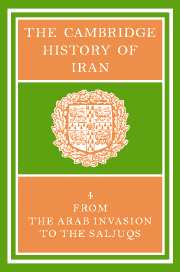Book contents
- Frontmatter
- 1 THE ARAB CONQUEST OF IRAN AND ITS AFTERMATH
- 2 THE ‘ABBĀSID CALIPHATE IN IRAN
- 3 THE ṬĀHIRIDS AND ṢAFFĀRIDS
- 4 The SĀMĀNIDS
- 5 THE EARLY GHAZNAVIDS
- 6 THE MINOR DYNASTIES OF NORTHERN IRAN
- 7 IRAN UNDER THE BŪYIDS
- 8 TRIBES, CITIES AND SOCIAL ORGANIZATION
- 9 THE VISUAL ARTS
- 10 NUMISMATICS
- 11 THE EXACT SCIENCES
- 12 LIFE SCIENCES, ALCHEMY AND MEDICINE
- 13(a) PHILOSOPHY AND COSMOLOGY
- (b) SŪFISM
- 14 THE RELIGIOUS SCIENCES
- 15 SECTS AND HERESIES
- 16 NĀSIR-I KHUSRAU AND IRANIAN ISMĀ‘ĪLĪSM
- 17 ZOROASTRIAN LITERATURE AFTER THE MUSLIM CONQUEST
- 18 ARABIC LITERATURE IN IRAN
- 19 THE RISE OF THE NEW PERSIAN LANGUAGE
- 20 (a) THE “RUBĀ'Ī” IN EARLY PERSIAN LITERATURE
- (b) ‘UMAR KHAYYĀM: ASTRONOMER, MATHEMATICIAN AND POET
- Bibliography
- Index
- Plate section
- Plate section">
- Map 1. Iran under the Abbasids">
- References
15 - SECTS AND HERESIES
Published online by Cambridge University Press: 28 March 2008
- Frontmatter
- 1 THE ARAB CONQUEST OF IRAN AND ITS AFTERMATH
- 2 THE ‘ABBĀSID CALIPHATE IN IRAN
- 3 THE ṬĀHIRIDS AND ṢAFFĀRIDS
- 4 The SĀMĀNIDS
- 5 THE EARLY GHAZNAVIDS
- 6 THE MINOR DYNASTIES OF NORTHERN IRAN
- 7 IRAN UNDER THE BŪYIDS
- 8 TRIBES, CITIES AND SOCIAL ORGANIZATION
- 9 THE VISUAL ARTS
- 10 NUMISMATICS
- 11 THE EXACT SCIENCES
- 12 LIFE SCIENCES, ALCHEMY AND MEDICINE
- 13(a) PHILOSOPHY AND COSMOLOGY
- (b) SŪFISM
- 14 THE RELIGIOUS SCIENCES
- 15 SECTS AND HERESIES
- 16 NĀSIR-I KHUSRAU AND IRANIAN ISMĀ‘ĪLĪSM
- 17 ZOROASTRIAN LITERATURE AFTER THE MUSLIM CONQUEST
- 18 ARABIC LITERATURE IN IRAN
- 19 THE RISE OF THE NEW PERSIAN LANGUAGE
- 20 (a) THE “RUBĀ'Ī” IN EARLY PERSIAN LITERATURE
- (b) ‘UMAR KHAYYĀM: ASTRONOMER, MATHEMATICIAN AND POET
- Bibliography
- Index
- Plate section
- Plate section">
- Map 1. Iran under the Abbasids">
- References
Summary
The religious evolution of Iran during the centuries from the Arab conquest to the rise of the Saljuqs was determined by a number of factors which, so far, have not been adequately isolated and analysed. A religious history of Iran during this period still lacks data and analyses to enable the student of the history of religions to make a religious typology, and to differentiate its internal structure and verify its socio-political connections. In dealing with heterodoxy in Iran, the difficulty of focusing on problems is further compounded by the fact that, in most instances, one cannot rely on contemporary sources, which might be properly characterized as “heterodox”, as free expressions of the antithesis to the official religious set-up of Iran following the Arab conquest. The oldest and most exhaustive work on Shī‘ī heresiography, Naubakhtī's Firaq al-shī‘a, only dates from the 4th/10th century.
One is thus faced by interpretations which are biased from the very beginning, due to the strongly felt need of condemning heresy and keeping it at a safe distance so as to leave no doubt as to the “orthodox” soundness of the sources. Alternatively, most of the material employed reflects the centrally oriented and Islamic views of the caliphal empire, within which Iran, as any other province, was a mere ramification of a single, powerful centre which was bound, by the nature of things, to peripheral repetition of its basic modules and patterns.
By concentrating on one area or province one can attain a more realistic, although possibly still universal vision, which is important for a number of interrelations between the various areas or provinces, and above all takes into account whatever each area more or less consciously chose to preserve, in a “national” sense as one might say today, out of the supranational whole of aims and interests which the caliphate's Islamic ideology expressed in different occasions and forms, within the territorial boundaries of the caliphate.
Keywords
- Type
- Chapter
- Information
- The Cambridge History of Iran , pp. 481 - 519Publisher: Cambridge University PressPrint publication year: 1975
References
- 4
- Cited by

